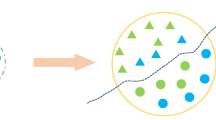Abstract
In this paper, we propose a transfer domain class clustering (TDCC) algorithm to address the unsupervised domain adaptation problem, in which the training data (source domain) and the test data (target domain) follow different distributions. TDCC aims to derive new feature representations for source and target in a latent subspace to simultaneously reduce the distribution distance between two domains, which helps transfer the source knowledge to the target domain effectively, and enhance the class discriminativeness of data as much as possible by minimizing the intra-class variations, which can benefit the final classification a lot. The effectiveness of TDCC is verified by comprehensive experiments on several cross-domain datasets, and the results demonstrate that TDCC is superior to the competitive algorithms.
Access this chapter
Tax calculation will be finalised at checkout
Purchases are for personal use only
Similar content being viewed by others
References
Pan SJ, Yang Q (2010) A survey on transfer learning. IEEE Trans Knowl Data Eng 22(10):1345–1359
Long M, Wang J, Ding G et al (2014) Transfer joint matching for unsupervised domain adaptation. In: Proceedings of the IEEE conference on computer vision and pattern recognition, pp 1410–1417
Long M, Wang J, Ding G et al (2013) Transfer feature learning with joint distribution adaptation. In: Proceedings of the IEEE international conference on computer vision, pp 2200–2207
Li S, Song S, Huang G (2016) Prediction reweighting for domain adaptation. IEEE Trans Neural Netw Learn Syst
Pan SJ, Tsang IW, Kwok JT et al (2011) Domain adaptation via transfer component analysis. IEEE Trans Neural Netw 22(2):199–210
Suykens JAK, Vandewalle J (1999) Least squares support vector machine classifiers. Neural Process Lett 9(3):293–300
Fukunaga K, Narendra PM (1975) A branch and bound algorithm for computing k-nearest neighbors. IEEE Trans Comput 100(7):750–753
Gretton A, Borgwardt KM, Rasch MJ et al (2013) A kernel two-sample test. J Mach Learn Res 13:723–773
Jolliffe I (2002) Principal component analysis. Wiley
Schölkopf B, Smola A, Müller KR (1998) Nonlinear component analysis as a kernel eigenvalue problem. Neural Comput 10(5):1299–1319
Gong B, Shi Y, Sha F et al (2012) Geodesic flow kernel for unsupervised domain adaptation. In: Computer vision and pattern recognition (CVPR), 2012 IEEE Conference on IEEE, pp 2066–2073
Wang H, Wang W, Zhang C et al (2014) Cross-domain metric learning based on information theory. AAAI, pp 2099–2105
Acknowledgements
This research is supported by the CRRC Major Scientific Projects under Grant No. 2106CKZ206-1 and National Key R&D Program under Grant No. 2016YFB1200203.
Author information
Authors and Affiliations
Corresponding author
Editor information
Editors and Affiliations
Rights and permissions
Copyright information
© 2018 Springer Nature Singapore Pte Ltd.
About this paper
Cite this paper
Fan, Y., Yan, G., Li, S., Song, S., Wang, W., Peng, X. (2018). Transfer Domain Class Clustering for Unsupervised Domain Adaptation. In: Jia, L., Qin, Y., Suo, J., Feng, J., Diao, L., An, M. (eds) Proceedings of the 3rd International Conference on Electrical and Information Technologies for Rail Transportation (EITRT) 2017. EITRT 2017. Lecture Notes in Electrical Engineering, vol 482. Springer, Singapore. https://doi.org/10.1007/978-981-10-7986-3_83
Download citation
DOI: https://doi.org/10.1007/978-981-10-7986-3_83
Published:
Publisher Name: Springer, Singapore
Print ISBN: 978-981-10-7985-6
Online ISBN: 978-981-10-7986-3
eBook Packages: EnergyEnergy (R0)




